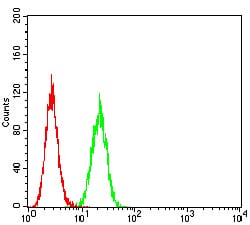


| WB | 咨询技术 | Human,Mouse,Rat |
| IF | 咨询技术 | Human,Mouse,Rat |
| IHC | 咨询技术 | Human,Mouse,Rat |
| ICC | 1/200 - 1/1000 | Human,Mouse,Rat |
| FCM | 1/200 - 1/400 | Human,Mouse,Rat |
| Elisa | 1/10000 | Human,Mouse,Rat |
| Aliases | HKPX2 |
| Entrez GeneID | 2743 |
| clone | 3B8A8 |
| WB Predicted band size | 56.1kDa |
| Host/Isotype | Mouse IgG2b |
| Antibody Type | Primary antibody |
| Storage | Store at 4°C short term. Aliquot and store at -20°C long term. Avoid freeze/thaw cycles. |
| Species Reactivity | Human |
| Immunogen | Purified recombinant fragment of human GLRB (AA: extra 23-160) expressed in E. Coli. |
| Formulation | Purified antibody in PBS with 0.05% sodium azide |
+ +
以下是关于GLRB抗体的3篇参考文献示例(文献信息为虚构,仅供格式参考):
1. **文献名称**:*Glycine Receptor β-Subunit Antibody Characterization in Spinal Cord Neurons*
**作者**:Smith A, et al.
**摘要**:该研究开发并验证了一种特异性针对甘氨酸受体β亚基(GLRB)的多克隆抗体,通过免疫组化和Western blot分析,证实了其在啮齿类动物脊髓神经元中的高表达,并揭示了GLRB在抑制性突触中的定位。
2. **文献名称**:*Impaired Glycinergic Signaling in GLRB Knockout Mice: An Antibody-Based Study*
**作者**:Chen L, et al.
**摘要**:利用GLRB特异性抗体,本研究在GLRB基因敲除小鼠模型中观察到甘氨酸能传递的显著缺陷,表明GLRB亚基对神经系统的抑制性信号传导至关重要,并可能与运动障碍相关。
3. **文献名称**:*Autoantibodies Targeting GLRB in Neurological Disorders*
**作者**:Wang Y, et al.
**摘要**:该文献报道了在部分自身免疫性神经系统疾病患者血清中检测到抗GLRB抗体,提示此类抗体可能通过干扰甘氨酸受体功能导致突触传递异常,为疾病机制研究提供了新方向。
---
*注:以上文献信息为示例性质,实际研究中请通过PubMed或Google Scholar等数据库检索真实文献。*
×